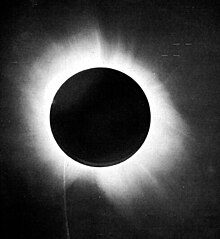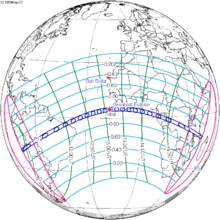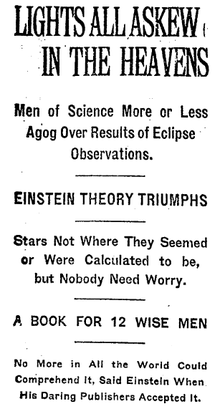Welcome to DU!
The truly grassroots left-of-center political community where regular people, not algorithms, drive the discussions and set the standards.
Join the community:
Create a free account
Support DU (and get rid of ads!):
Become a Star Member
Latest Breaking News
General Discussion
The DU Lounge
All Forums
Issue Forums
Culture Forums
Alliance Forums
Region Forums
Support Forums
Help & Search
Science
Related: About this forumHappy 100th Anniversary (a little late), the Eddington Expedition
Eddington experiment

The 29 May 1919 solar eclipse
The Eddington experiment was an observational test of General Relativity, organised by the British astronomers Frank Watson Dyson and Arthur Stanley Eddington in 1919. The observations were of the total solar eclipse of 29 May 1919 and were carried out by two expeditions, one to the West African island of Príncipe, and the other to the Brazilian town of Sobral. The aim of the expeditions was to measure the gravitational deflection of starlight passing near the Sun. The value of this deflection had been predicted by Albert Einstein in a 1911 paper, and was one of the tests proposed for his 1915 theory of General Relativity. Following the return of the expeditions, the results were presented by Eddington to the Royal Society of London, and, after some deliberation, were accepted. Widespread newspaper coverage of the results led to worldwide fame for Einstein and his theories.
....
Expeditions and observations
The aim of the expeditions was to take advantage of the shielding effect of the Moon during a total solar eclipse, and to use astrometry to measure the positions of the stars in the sky around the Sun during the eclipse. These stars, not normally visible in the daytime due to the brightness of the Sun, would become visible during the moment of totality when the Moon covered the solar disc. A difference in the observed position of the stars during the eclipse, compared to their normal position at night, would indicate that the light from these stars had bent as it passed close to the Sun. Dyson, when planning the expedition in 1916, had chosen the 1919 eclipse because it would take place with the Sun in front of a bright group of stars called the Hyades. The brightness of these stars would make it easier to measure any changes in position.
Two teams of two people were to be sent to make observations of the eclipse at two locations: the West African island of Príncipe and the Brazilian town of Sobral.
The Príncipe expedition members were Eddington and Edwin Turner Cottingham, from the Cambridge Observatory, while the Sobral expedition members were Andrew Crommelin and Charles Rundle Davidson, from the Greenwich Observatory in London. Eddington was Director of the Cambridge Observatory, and Cottingham was a clockmaker who worked on the observatory's instruments. Similarly, Crommelin was an assistant at the Greenwich Observatory, while Davidson was one of the observatory's computers.
The expeditions were organised by the Joint Permanent Eclipse Committee, a joint committee between the Royal Society and the Royal Astronomical Society, chaired by Dyson, the Astronomer Royal. The funding application for the expedition was made to the Government Grant Committee, asking for £100 for instruments and £1000 for travel and other costs.
Sobral

Map of the path of totality for the eclipse
The Sobral equipment included one astrographic lens from the Greenwich Observatory, and another from the Royal Irish Academy.
Principe
The equipment used for the Principe expedition was an astrographic lens borrowed from the Radcliffe Observatory in Oxford. Eddington sailed from England in March 1919. By mid-May he had his equipment set up on Principe, an island in the Gulf of Guinea off the coast of West Africa, near what was then Spanish Guinea. The eclipse was due to take place in the early afternoon of 29 May, at 2pm, but that morning there was a storm with heavy rain. Eddington wrote:
Eddington developed the photographs on Principe, and attempted to measure the change in the stellar positions during the eclipse. On 3 June, despite the clouds that had reduced the quality of the plates, Eddington recorded in his notebook: "... one plate I measured gave a result agreeing with Einstein."
....
Immediate impact

The New York Times of November 10, 1919, reported on Einstein's confirmed prediction
The result was considered spectacular news and made the front page of most major newspapers. It made Einstein and his theory of general relativity world famous. Einstein has been quoted as describing what his reaction would have been if general relativity had not been confirmed by Eddington and Dyson in 1919: "Then I would feel sorry for the dear Lord. The theory is correct anyway."
....

The 29 May 1919 solar eclipse
The Eddington experiment was an observational test of General Relativity, organised by the British astronomers Frank Watson Dyson and Arthur Stanley Eddington in 1919. The observations were of the total solar eclipse of 29 May 1919 and were carried out by two expeditions, one to the West African island of Príncipe, and the other to the Brazilian town of Sobral. The aim of the expeditions was to measure the gravitational deflection of starlight passing near the Sun. The value of this deflection had been predicted by Albert Einstein in a 1911 paper, and was one of the tests proposed for his 1915 theory of General Relativity. Following the return of the expeditions, the results were presented by Eddington to the Royal Society of London, and, after some deliberation, were accepted. Widespread newspaper coverage of the results led to worldwide fame for Einstein and his theories.
....
Expeditions and observations
The aim of the expeditions was to take advantage of the shielding effect of the Moon during a total solar eclipse, and to use astrometry to measure the positions of the stars in the sky around the Sun during the eclipse. These stars, not normally visible in the daytime due to the brightness of the Sun, would become visible during the moment of totality when the Moon covered the solar disc. A difference in the observed position of the stars during the eclipse, compared to their normal position at night, would indicate that the light from these stars had bent as it passed close to the Sun. Dyson, when planning the expedition in 1916, had chosen the 1919 eclipse because it would take place with the Sun in front of a bright group of stars called the Hyades. The brightness of these stars would make it easier to measure any changes in position.
Two teams of two people were to be sent to make observations of the eclipse at two locations: the West African island of Príncipe and the Brazilian town of Sobral.
The Príncipe expedition members were Eddington and Edwin Turner Cottingham, from the Cambridge Observatory, while the Sobral expedition members were Andrew Crommelin and Charles Rundle Davidson, from the Greenwich Observatory in London. Eddington was Director of the Cambridge Observatory, and Cottingham was a clockmaker who worked on the observatory's instruments. Similarly, Crommelin was an assistant at the Greenwich Observatory, while Davidson was one of the observatory's computers.
The expeditions were organised by the Joint Permanent Eclipse Committee, a joint committee between the Royal Society and the Royal Astronomical Society, chaired by Dyson, the Astronomer Royal. The funding application for the expedition was made to the Government Grant Committee, asking for £100 for instruments and £1000 for travel and other costs.
Sobral

Map of the path of totality for the eclipse
The Sobral equipment included one astrographic lens from the Greenwich Observatory, and another from the Royal Irish Academy.
Principe
The equipment used for the Principe expedition was an astrographic lens borrowed from the Radcliffe Observatory in Oxford. Eddington sailed from England in March 1919. By mid-May he had his equipment set up on Principe, an island in the Gulf of Guinea off the coast of West Africa, near what was then Spanish Guinea. The eclipse was due to take place in the early afternoon of 29 May, at 2pm, but that morning there was a storm with heavy rain. Eddington wrote:
“The rain stopped about noon and about 1.30 ... we began to get a glimpse of the sun. We had to carry out our photographs in faith. I did not see the eclipse, being too busy changing plates, except for one glance to make sure that it had begun and another half-way through to see how much cloud there was. We took sixteen photographs. They are all good of the sun, showing a very remarkable prominence; but the cloud has interfered with the star images. The last few photographs show a few images which I hope will give us what we need ...”
Eddington developed the photographs on Principe, and attempted to measure the change in the stellar positions during the eclipse. On 3 June, despite the clouds that had reduced the quality of the plates, Eddington recorded in his notebook: "... one plate I measured gave a result agreeing with Einstein."
....
Immediate impact

The New York Times of November 10, 1919, reported on Einstein's confirmed prediction
The result was considered spectacular news and made the front page of most major newspapers. It made Einstein and his theory of general relativity world famous. Einstein has been quoted as describing what his reaction would have been if general relativity had not been confirmed by Eddington and Dyson in 1919: "Then I would feel sorry for the dear Lord. The theory is correct anyway."
....
InfoView thread info, including edit history
TrashPut this thread in your Trash Can (My DU » Trash Can)
BookmarkAdd this thread to your Bookmarks (My DU » Bookmarks)
0 replies, 636 views
ShareGet links to this post and/or share on social media
AlertAlert this post for a rule violation
PowersThere are no powers you can use on this post
EditCannot edit other people's posts
ReplyReply to this post
EditCannot edit other people's posts
Rec (9)
ReplyReply to this post